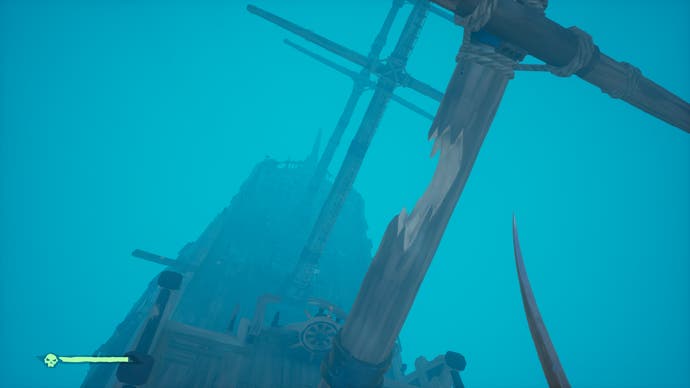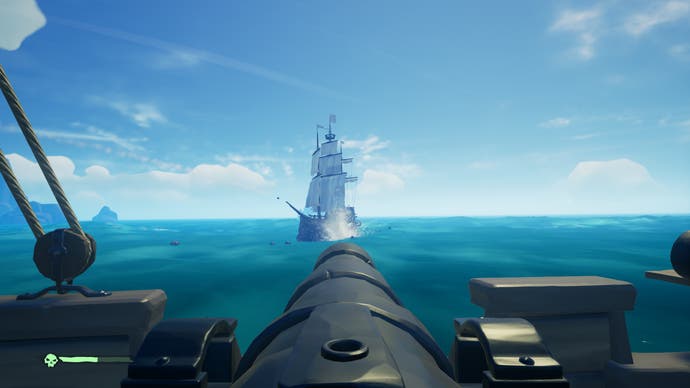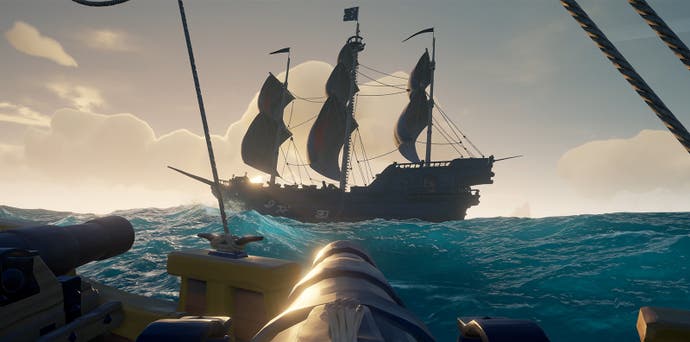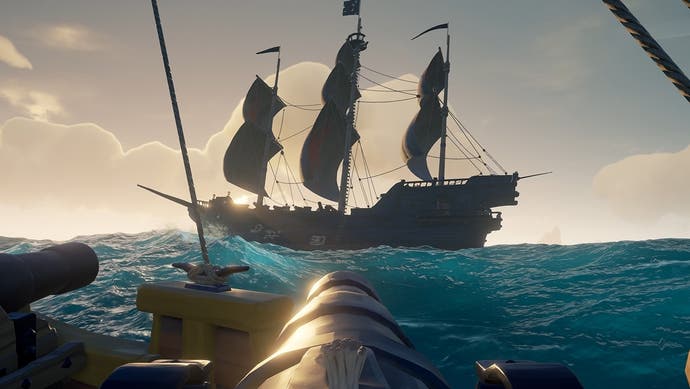Sea of Thieves ship battles: How to win, use cannons and repair your sinking ship explained
How to survive (or hunt other ships) on the open seas.
Sea of Thieves' ship battles are one of those skills worth learning if you come against trouble on the high seas - which is unfortunately often.
The principles of combat are largely the same between ships, but the actual putting into practice of those really depends on the size of your ship and crew.
This page explains how to defeat other ships to the basics of cannons and cannonballs and, once the battle is over (or, if you have a team with you!) how to repair your sinking ship.
On this page:
If you're looking to learn the essentials of Sea of Thieves, take part in the Maiden Voyage, and read more about sailing and how to survive fights with skeletons and the kraken.
How to win ship battles in Sea of Thieves
First, you should learn the essentials of how to sail in Sea of Thieves - as once you have mastered how to move, you can then fight back more effectively.
From there, here's some advice on how to fight in Sea of Thieves:
- Weigh up the risks and rewards before you engage - How much loot do you have on board? How much do they have? How many of them are there compared to you? How much damage have you taken already? Are you any good at aiming?! Answer all of these before you decide to attack - you never know, if you didn't fire that pointless potshot they might have ignored you anyway.

- Don't sail front-on into an enemy - Not literally "don't crash into an enemy" (that can actually be a useful last resort...), but don't drive towards them head-on, especially if they're facing you side-on. In other words...
- Always keep the enemy to one side - This is because your cannons are on the side, and can't shoot directly forwards or backwards. The longer you keep enemies to your side and within the range of cannons, the better chance you have of winning a duel.
- Keep your lights off - The lanterns around your ship can all be turned off, and this makes a massive difference to your visibility, especially at long distances. If you want to avoid being seen - either to avoid combat or to sneak up on enemies - then the rapid day/night cycle makes turning off your lamps is essential.
- Stay calm! - It's dead easy to panic when you're attacked out of the blue, but try to keep your head. Staying more organised and sticking to your roles will make a massive difference to your chances of success.
- Assign roles quickly - Get your scout off the crow's nest and onto repairs duty, for instance, and make sure everyone know's what they're responsible for and that the essentials (steering, repairs, cannons, fighting invaders) are covered before anything else.
- The best offence is sometimes the best defence, sometimes it's really not - Firing pirates out of cannons onto enemy ships is ridiculously fun, but there's a huge margin for error. If you do manage to get onto their ship, try to either: drop their anchor (to slow them down and make them easier to hit with cannons); blow up some explosive barrels; or distract people trying to repair the ship below deck.

- You can scuttle your ship if they nick it - The same idea as voting someone into the Brig, you can scuttle (sink and respawn) your ship if your team votes for it at any time. This is what you do if it gets stolen from you and there's no chance of getting it back.
- Go for the broadside - This is the ultimate goal, really, especially on a galleon. A broadside is when you get a full side of your ship firing at an enemy ship, ideally on repeat. If someone charges at you head-on, if you can turn to the side and nail them with several cannons firing at once, it's near impossible to lose.
- Aim cannons low - Damaging their ship above the waterline does nothing but send pirates flying if you manage to hit one. Your goal is to sink the ship, and to do that you need to damage it at or below water level, so try to hit their shop as low as possible to be most effective. Don't waste ammo if you're too close to hit them at the right height.
- Focus down invaders fast - It might seem counterintuitive to take people off their duties to kill a single attacker, but it's much worse to leave them wreaking havoc in one-on-ones than it is for several of you to quickly burst them down.
- Finally, stay prepared! - Fail to prepare and prepare to fail, etc. Whenever you set sail, do these things: stock up on bananas, cannonballs and wooden planks from the island where you're docked, making sure the on-ship stores are full and you have a few in your own inventory too. Fill every cannon with a cannonball from the start, so you can immediately fire when needed. Always have your weapon fully loaded when you're on a ship in peacetime, as it's a nightmare running below deck to reload in the middle of combat, and finally: always be on the lookout for enemies! With the wind in their favour, it's amazing how quickly you can be ambushed. Eyes on the horizon, mateys!
How to use Cannons and Cannonballs in Sea of Thieves
Cannons are the bread and butter of combat, and can be loaded with a variety of different cannonball simply by holding them aloft and interacting with the nearest end of the cannon. Once loaded (you can tell if they're loaded at a glance if there's a short stub of rope sticking out the rear), simply grab hold to shift its position, take aim at your target, and fire. Usefully, provided you have more ammo in your inventory, cannons can be reloaded at the press of a button, without needed to detach yourself.
Fearless sorts can load themselves into the open end of a cannon, and blast off to distant climes (you'll need to aim beforehand if doing this solo). This is useful if you ever want to rapidly reach higher ground on an island, reach otherwise inaccessible ledges, or even cross vast distances of the ocean to infiltrate an enemy ship at speed. Do be aware that you'll take damage if you hit solid ground from a significant height when firing, but not when landing in water.

Since launch, the number of available cannon projectiles has ballooned, and you'll find a full breakdown of those available, and their various effects, below:
Standard cannonballs - useful for puncturing holes in an opponent's lower deck, or smashing their mast, wheel, or capstan. Blunder bombs - cause minimal impact damage but can nudge a vessel on its axis, usefully knocking enemy cannons off-target. Fire bombs - set fire to the impact zone, with flames slowly spreading until extinguished with water. Chain shot - a spinning chain that causes minimal damage to the hull but can obliterate a vessel's mast, wheel, or capstan in a single strike, forcing a frantic repair. Cursed Cannonballs - don't deal damage direct damage, but inflict troublesome effects on ships (purple cursed cannonballs) or crew members (green cursed cannonballs) caught in the blast radius.
Purple Cursed Cannonballs
- Anchorball - raises or lowers anchor of ship caught in impact.
- Ballastball - lowers ship in water, forcing it to take in water from holes one deck higher than normal.
- Barrelball - prevents access to all supply barrels for a short time.
- Helmball - locks ship's wheel for a short time.
- Peaceball - raises all cannons in impact zone to highest angle.
- Riggingball - raises all sails, slowing effected ship down to lowest speed.
Green Cursed Cannonballs
- Grogball - makes players drunk for a short time.
- Jigball - makes players dance on the spot for a short time.
- Limpball - restricts player movement speed for a short time.
- Venomball - poisons players for a short time.
- Wearyball - sends players to sleep for a short time.
The first season has arrived! Learn about all Season 1 Battle Pass rewards and everything else added in the Sea of Thieves patch notes. New to the game? Learn what to do in Sea of Thieves and take take part in the Maiden Voyage tutorial, which teaches you the essentials of sailing and ship battles. It's also useful for beginners to know how to survive fights with skeletons and the kraken. Elsewhere we have advice on how to get easy gold and doubloons, complete skeleton forts and The Shroudbreaker, take part in fishing in Sea of Thieves and Sea of Thieves island maps.
How to repair you sinking ship in Sea of Thieves
All boats have four main damage zones - the hull, wheel, capstan, and mast - that can be variously effected by projectiles, environmental hazards, large enemies, or simply through careless driving. A damaged hull will let in water eventually causing the ship to sink, while the wheel, capstan, and mast will cease to function if completely damaged, so it's vital to perform repairs as quickly as possible.
Performing a repair simply requires a crew member to equip a plank, then interact with the damaged spot to patch it up. Larger holes in the hull will require longer to repair than smaller ones (don't forget to bail water from the lower decks over the sides of the boat when you're done!), and multiple planks will be needed to fix the capstan, wheel, and mast if they've sustained multiple damage. Note that completely broken sails must be hoisted back into position using their ropes before planks can be used on their damage zones.
Although the repairs you prioritise will depend on your current circumstances, you'll usually want to focus on repairing the hull first when sailing a galleon or brigantine, as water pours in quickly, making it difficult to bail fast enough to prevent sinking. Sloops, meanwhile, fill up relatively slowly, meaning it's sometimes preferable to escape a danger zone first, allowing water to steadily pour in below deck, and then repairing once in a safer position. In all cases, you'll know your boat is about to sink when it begins to make a violent groaning.
Do note that holes above water level don't take in water, meaning you can leave those until last - unless hit by a Ballastball or in rough, stormy waters.









